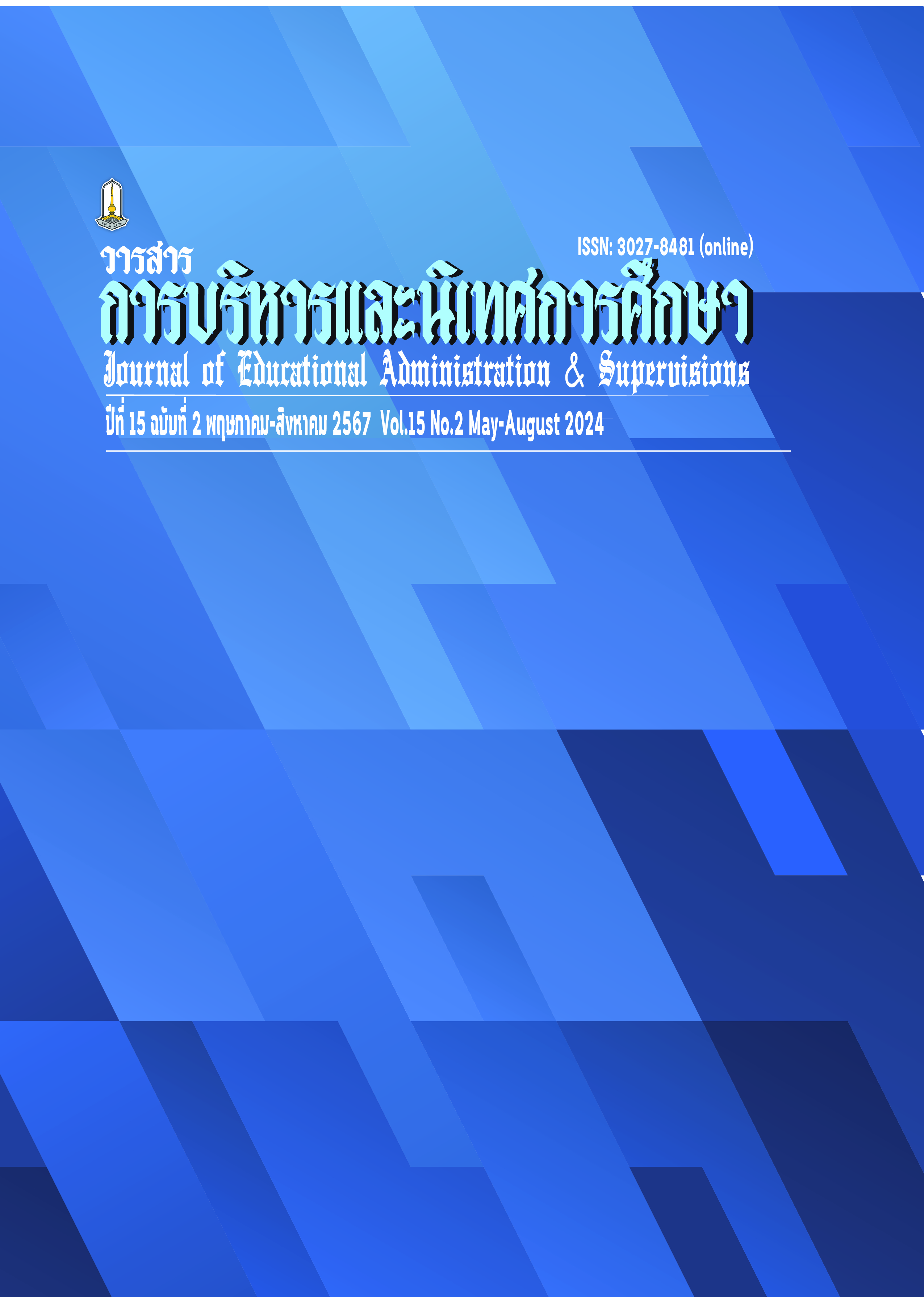Guidelines for Developing Organizational Climate in School under the Nakhon Ratchasima Primary Educational Service Area Office 2
Main Article Content
Abstract
The purposes of this research were to study organizational climate and to compare organizational climate in schools, classified by the size of educational institution, and the guidelines for developing the organizational climate in school under the Nakhon Ratchasima Primary Educational Service Area Office 2. The samples included 30 school administrators and 297 teachers, total 327 people. The sample was determined according to Krejcie and Morgan’s table and stratified random sampling. The target group included 5 people. The tools used in data collection included questionnaires, the reliability was .985 and semi-structed interviews. Data analyzation included percentage, means, standard deviation, t-test independent and content analysis. Then, the results were summarized in a descriptive essay. The research results revealed that 1) The organizational climate of school as whole and in each aspect was in the high level. 2) The comparison of the school organizational climate was found that there are no different in the overall. When considering in each aspect, it was found that there are no different in standard and organization structure. The remaining aspects were different with statistical significance at .05 level. 3) The guidelines for developing the organizational climate of school revealed that, In the aspect of warmth and support, the principal should adhere to principals of good governance, and support the personnel in the activities that enhance coordination and team-working. In the aspect of opportunity and development, the principal should always be encouraged teachers and personnel to develop themselves professionally. In the aspect of rewarding, the principal should use the principles of fairness and rewarding by considering from the empirical performance. In the aspect of standards, the principal should use the rule of law in the development of working standards; set the clear working patterns, which staffs take parts in setting the goals and provide the friendly supervision. In the aspect of organization structure. the principal should divide management into 4 sections and the scope of duty were clearly defined.
Downloads
Article Details
References
กระทรวงศึกษาธิการ. (2552). ข้อเสนอการปฏิรูปการศึกษาในทศวรรษที่สอง (พ.ศ. 2552-2561). สำนักนโยบายและแผนการศึกษา สำนักงานเลขาธิการสภาการศึกษา.
กิรชัญญา ของโพธิ์. (2565). บรรยากาศองค์การที่ส่งผลต่อประสิทธิภาพการทำงานในยุคดิจิทัลของบุคลากร สำนักงานคณะกรรมการการศึกษาขั้นพื้นฐาน (ส่วนกลาง). [การศึกษารายบุคคลปริญญามหาบัณฑิต ไม่ได้ตีพิมพ์]. มหาวิทยาลัยธุรกิจบัณฑิตย์.
จตุพร สุทธิสะอาด. (2562). ความสัมพันธ์ระหว่างบรรยากาศองค์การกับประสิทธิผลของโรงเรียนกลุ่มศรีราชา 4 สังกัดสำนักงานเขตพื้นที่การศึกษาประถมศึกษาชลบุรี เขต 3. [วิทยานิพนธ์ปริญญามหาบัณฑิต ไม่ได้ตีพิมพ์]. มหาวิทยาลัยบูรพา.
จักรพงษ์ พิลาจันทร์. (2563). การศึกษาบรรยากาศองค์การของสถานศึกษา ที่ส่งผลต่อสมรรถนะที่พึงประสงค์ สำหรับครูผู้สอนในสถานศึกษา สังกัดสำนักงานเขตพื้นที่การศึกษามัธยมศึกษา เขต 20. [วิทยานิพนธ์ ปริญญามหาบัณฑิต ไม่ได้ตีพิมพ์]. วิทยาลัยสันตพล.
ทิศนา แขมมณี. (2560). ศาสตร์การสอน : องค์ความรู้เพื่อการจัดกระบวนการเรียนรู้ที่มีประสิทธิภาพ
(พิมพ์ครั้งที่ 21). สำนักพิมพ์แห่งจุฬาลงกรณ์มหาวิทยาลัย.
ธนัทพงษ์ วังทะพันธ์. (2564). บรรยากาศองค์การที่ส่งผลต่อความเป็นองค์การแห่งการเรียนรู้ของโรงเรียน สังกัดสำนักงานเขตพื้นที่การศึกษามัธยมศึกษานครพนม. [วิทยานิพนธ์ปริญญามหาบัณฑิต ไม่ได้ตีพิมพ์]. มหาวิทยาลัยราชภัฏสกลนคร.
ธีรศักดิ์ มังคุด. (2564). บรรยากาศองค์การที่ส่งผลต่อการบริหารงานวิชาการของโรงเรียนสังกัดสำนักงานเขตพื้นที่การศึกษามัธยมศึกษา เขต 9. [วิทยานิพนธ์ปริญญามหาบัณฑิต ไม่ได้ตีพิมพ์]. มหาวิทยาลัยศิลปากร.
นเรศรี แสนมนตรี. (2553). บรรยากาศองค์การและความผูกพันต่อองค์การของข้าราชการตำรวจตระเวนชายแดนที่ 23 อำเภอเมือง จังหวัดสกลนคร. [วิทยานิพนธ์ปริญญามหาบัณฑิต ไม่ได้ตีพิมพ์]. มหาวิทยาลัยราชภัฏสกลนคร.
บุญชม ศรีสะอาด. (2554). วิธีการวิจัยเบื้องต้น (พิมพ์ครั้งที่ 9). สุวีริยาสาสน์.
พัชชานันท์ โภชฌงค์. (2562). บรรยากาศองค์การกับประสิทธิผลของโรงเรียนสังกัดสำนักงานเขตพื้นที่การศึกษามัธยมศึกษา เขต 3. [วิทยานิพนธ์ปริญญามหาบัณฑิต ไม่ได้ตีพิมพ์]. มหาวิทยาลัยศิลปากร.
พีระ แก้วสอาด. (2564). อิทธิพลของบรรยากาศองค์การที่ส่งผลต่อความผูกพันต่อองค์การของพนักงานบมจ.ธนาคารกรุงไทย สำนักงานใหญ่. [วิทยานิพนธ์ปริญญามหาบัณฑิต ไม่ได้ตีพิมพ์]. มหาวิทยาลัยศรีนครินทรวิโรฒ.
สมศักดิ์ คงเที่ยง และอัญชลี โพธิ์ทอง. (2550). การบริหารบุคลากรและการพัฒนาทรัพยากรมนุษย์.
ภาควิชาการบริหารการศึกษาและอุดมศึกษา คณะศึกษาศาสตร์ มหาวิทยาลัยรามคำแหง.
สำนักงานเขตพื้นที่การศึกษาประถมศึกษานครราชสีมา เขต 2. (30 มกราคม 2566). แผนปฏิบัติการ
ประจำปีงบประมาณ พ.ศ. 2566. https://www.korat2.go.th/?page_id=163
สุนิสา เนาวรัตน์. (2563). ปัจจัยที่ส่งผลต่อบรรยากาศองค์การของโรงเรียนสังกัดสำนักงานเขตพื้นที่การศึกษา มัธยมศึกษา เขต 2. วารสารครุศาสตร์ คณะครุศาสตร์ มหาวิทยาลัยราชภัฏกำแพงเพชร. 6(12), 82-101.
สุภัสสร ชูประยูร. (2563). การศึกษาบรรยากาศองค์การที่ส่งผลต่อประสิทธิภาพการสอนของครู สังกัดสำนักงานเขตพื้นที่การศึกษามัธยมศึกษา เขต 11 ในจังหวัดสุราษฎร์ธานี. วารสารนาคปริทรรศน์ มหาวิทยาลัยราชภัฏนครศรีธรรมราช, 12(3), 152-170.
วิวรรณดา เรืองแก้ว. (2565). บรรยากาศองค์กรและคุณภาพชีวิตการทำงานที่มีความสัมพันธ์กับความผูกพันต่อองค์กรของพนักงานเอกชนในเขตกรุงเทพมหานคร. [วิทยานิพนธ์ปริญญามหาบัณฑิต ไม่ได้ตีพิมพ์]. หาวิทยาลัยศรีนครินทรวิโรฒ.
Fox, R. S. (1973). School climate improvement : A challenge to the school administration. Phi Delta Kappa.
Krejcie, R. V., & Morgan, D. W. (1970). Determining sample size for research activities. Educational and Psychological Measurement, 30(3), 607–610.


